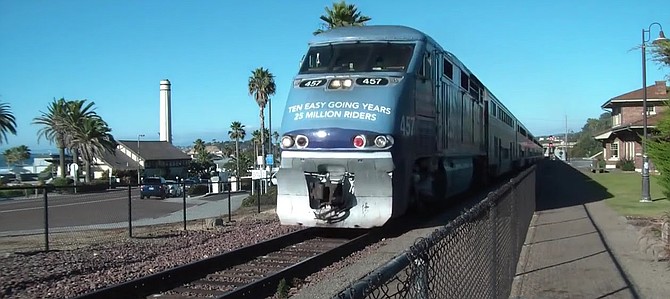 Facebook
Facebook
 X
X
 Instagram
Instagram
 TikTok
TikTok
 Youtube
Youtube

The city of Del Mar is still trying to figure out where to build the 113 affordable units it needs to meet state housing requirements, and it's gotten more complicated.
Many locals say a large complex would be out of place in the small city or on the bluffs. However, the 340-acre fairgrounds could easily fold in 61 of the low income units, despite the challenges of providing ingress and egress for those who live in the apartments, environmental and noise concerns, and impacts on fair operations.
But can the property also accommodate an underground train tunnel?
The city and fairgrounds have been working on a deal to bring about the affordable housing part, while the far bigger project has added a twist.
The San Diego Association of Governments is planning to move 1.7 miles of track inland, off the fragile bluffs, by 2035. A study of the Los Angeles-San Diego Rail Realignment weighed five potential locations; the current top two are tunnels under the city, along Camino Del Mar and Crest Canyon.
Some city council members are pushing for further study of a fairgrounds option.
In a letter to the city, fair officials warned that the pursuit of such an alternative would come "at the possible expense of our ability to continue with productive discussions regarding affordable housing."
Fairground officials were tipped off when the city in November announced it would vote on a set of nine guiding principles related to the rail realignment.
These principles "include an explicit call for SANDAG to conduct further study of a potential alignment that runs through and/or underneath" the fairgrounds, wrote Carlene Moore, chief executive officer of the 22nd District Agricultural Association.
She pointed out that it was still unknown whether any agreed-upon housing development plans might later be "significantly impacted by potential construction and/or future train service."
On Monday, mayor Tracy Martinez and council member Terry Gaasterland proposed a 10th guiding principle to add to the set passed in November.
The latest principle is specific to the fairgrounds: "SANDAG must respect and protect the operational, economic, environmental and planning needs of the 22nd DAA and of the proposed Del Mar housing program on the Fairgrounds, and as a key stakeholder, the 22nd DAA must be proactively engaged by SANDAG throughout the process."
While the city has no authority over the project or chosen alignment, its top priorities are getting the trains off the eroding bluffs and avoiding the taking of private property.
"The implications of a tunnel under residences are far worse than I could have imagined," one Del Mar dweller wrote to the city. For the Crest Canyon High Speed Route, one portal needed 10 acres of land, which, if located near residential zones, could potentially equal 43 lots taken.


The city of Del Mar is still trying to figure out where to build the 113 affordable units it needs to meet state housing requirements, and it's gotten more complicated.
Many locals say a large complex would be out of place in the small city or on the bluffs. However, the 340-acre fairgrounds could easily fold in 61 of the low income units, despite the challenges of providing ingress and egress for those who live in the apartments, environmental and noise concerns, and impacts on fair operations.
But can the property also accommodate an underground train tunnel?
The city and fairgrounds have been working on a deal to bring about the affordable housing part, while the far bigger project has added a twist.
The San Diego Association of Governments is planning to move 1.7 miles of track inland, off the fragile bluffs, by 2035. A study of the Los Angeles-San Diego Rail Realignment weighed five potential locations; the current top two are tunnels under the city, along Camino Del Mar and Crest Canyon.
Some city council members are pushing for further study of a fairgrounds option.
In a letter to the city, fair officials warned that the pursuit of such an alternative would come "at the possible expense of our ability to continue with productive discussions regarding affordable housing."
Fairground officials were tipped off when the city in November announced it would vote on a set of nine guiding principles related to the rail realignment.
These principles "include an explicit call for SANDAG to conduct further study of a potential alignment that runs through and/or underneath" the fairgrounds, wrote Carlene Moore, chief executive officer of the 22nd District Agricultural Association.
She pointed out that it was still unknown whether any agreed-upon housing development plans might later be "significantly impacted by potential construction and/or future train service."
On Monday, mayor Tracy Martinez and council member Terry Gaasterland proposed a 10th guiding principle to add to the set passed in November.
The latest principle is specific to the fairgrounds: "SANDAG must respect and protect the operational, economic, environmental and planning needs of the 22nd DAA and of the proposed Del Mar housing program on the Fairgrounds, and as a key stakeholder, the 22nd DAA must be proactively engaged by SANDAG throughout the process."
While the city has no authority over the project or chosen alignment, its top priorities are getting the trains off the eroding bluffs and avoiding the taking of private property.
"The implications of a tunnel under residences are far worse than I could have imagined," one Del Mar dweller wrote to the city. For the Crest Canyon High Speed Route, one portal needed 10 acres of land, which, if located near residential zones, could potentially equal 43 lots taken.
Comments